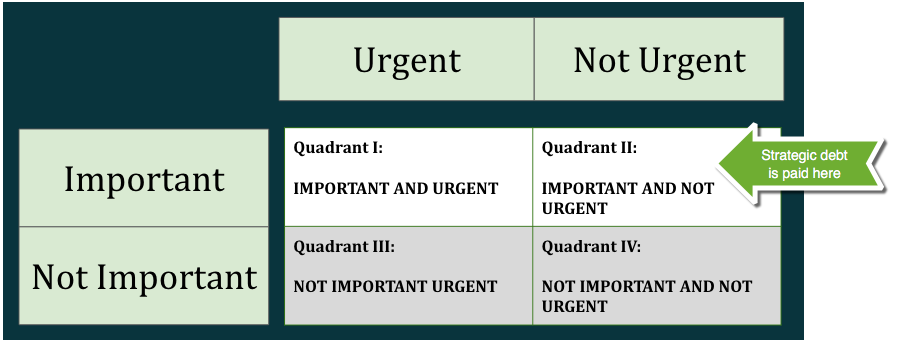 Strategic debt is a term that I came up with that describes the extra planning work that arises when a company forgoes strategic planning activities in exchange for short-term execution. Inspired by the term ‘technical debt’, the often cited pitfall of taking
Strategic debt is a term that I came up with that describes the extra planning work that arises when a company forgoes strategic planning activities in exchange for short-term execution. Inspired by the term ‘technical debt’, the often cited pitfall of taking
short-cuts when coding software, strategic debt is amplified as the company becomes more successful and grows, and it must be paid back before the organization can effectively execute and deliver on its vision. The interest of the debt, so to speak, becomes more crippling the longer the debt is deferred and the larger the organization gets.
Startups are often strapped for cash and need to get to market quickly. Time is at a premium and long-term thinking and planning are thought of as “do it after we are successful” activities while all resources are dedicated to achieving something that indicates success, such as revenue, evidence of product/market fit, buzz, whatever. Early-stage companies often thrive with this approach.Unfortunately, once the company makes it through this stage (for the ones that do) the model of “shoot first” has been ingrained in the culture and planning is often pushed to the side again, if not deplored. And that’s the paradox, the only way to breakthrough to the next level of scale is to pay off the strategic debt.
It’s not just startups, strategic debt happens in all different types and sizes of businesses. Any organization that does not step back and build a roadmap (or at least guardrails) for the long-haul, will incur strategic debt. In 7 Habits of Highly Effective People, Steven Covey introduced a tool he called a Time Management Grid to help people prioritize their task list. I think it is also relevant in the context of managing and/or building a business.

Quadrant I: This is the quadrant a lot of businesses, and people for that matter, are stuck in. This is where you GSD, and without it, your business would fail, and your life would fall apart. These are the things that you HAVE TO ADDRESS RIGHT NOW! The obvious examples are anything customer-facing, regulatory or life-and-death.
Quadrant II: An equally important, but highly neglected, quadrant. This is where strategic debt lives and must be paid off. Activities like strategic planning, organizational design, business intelligence, market research, resource planning, training, infrastructure development, are often set aside to address quadrant I.
Quadrant III: These are the time wasting activities that are time-sensitive, but don’t matter much. Think of that thing your boss needed ASAP, but never used.
Quadrant IV: these are activities that have no use, and are not time sensitive. From an organizational perspective, these are often habitual tasks that have little meaning or value; perhaps a bureaucratic construct, a seldom read status email, a feature that is maintained that nobody uses.
You want to spend as little time as possible in quadrant III and quadrant IV. Nothing meaningful happens there and it accelerates strategic debt.
There are few ways to use the time management matrix to recognize and minimize strategic debt:
- Carve out time specifically to be spent in quadrant II. This could mean implementing a regular cadence of different types of planning activities for your team or company.
- Recognize the difference between the not important and important urgent work
- Use this tool to prioritize your organization’s roadmap, and build a culture that can cut the fat.
As the strategic planner at Moz, a late-stage startup, I have dealt with strategic debt first hand. I will share my thoughts here on specific projects, actions, and philosophies that can be employed to pay the debt forward or back.
